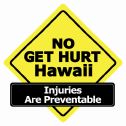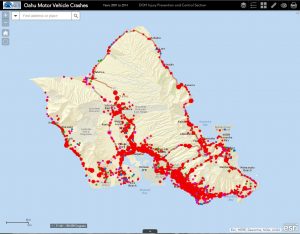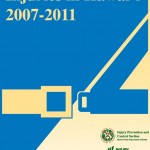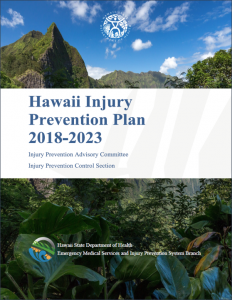Motorcycle and Moped Safety
Interactive map of EMS-attended Motor Vehicle Crashes on Oahu by Mode 2007-2018
Hawaii Laws: Mopeds and Motorcycles
1. Protective requirements for Motorcycle and Motor Scooter riders.
Motorcycles and Motor Scooter operators and passengers under the age of 18 are required to wear a helmet with a chin strap.
Children under 7 years old are prohibited from riding on motorcycles or motor scooters.
Operators of mopeds under the age 18 are required to wear a helmet with a chin strap
2. Laws Regarding Passengers
Motorcycles: Children under 7 years old are prohibited from riding on motorcycles or motor scooters.
Mopeds: Passengers are not permitted on mopeds.
3. Motorcycle and moped operators responsibilities
Motorcycle operators are required to abide by the laws and rules of the road.
Moped operators are required to abide by the laws and rules of the road.
4. Licensing, Safety and Training
Motorcycle operators must be licensed similar to motor vehicle drivers.
Steps include:
- Obtain a permit.
- Enroll in a motorcycle safety course.
- Pass motorcycle / motor scooter road test.
For additional information regarding motorcycles and mopeds, please visit our partners at HDOT at: Highways | Motorcycles, Motor Scooters and Mopeds General Information (hawaii.gov)
Motorcycle Safety Courses: These classes require you have a motorcycle permit prior to enrolling in the class. The class will prepare you for obtaining your motorcycle or motor scooter license.
Learn-to-Ride Classes are offered through the University of Hawaii – The class is an intensive course designed to prepare you for the streets. It consists of 10 hours of classroom work and 14 hours of hands-on training. No experience necessary and all equipment, including motorcycles, are supplied. Cost does apply, please contact for details.
See a preview of the motorcycle safety course here:
 |
Motorcycle Safety Foundation Rider Courses
Contact Number: 808-454-4746 Website: MSF Basic Rider Course |
On Oahu training takes place at Leeward Community College in Pearl City (across the freeway from Sam’s Club).
On Maui training takes place at both Maui Community College and at the War Memorial Stadium.
On the Big Island training takes place at Hawaii Community College.
For any information or questions on motorcycle safety training, please visit the Leeward Community College Office of Continuing Education & Workforce Development (OCEWD) website.
Moped operators must carry a driver’s license or instructional permit.
Data
Motor Vehicle Crashes & Motorcyclist Data Summary: Please refer to the updated 2008-2012 summary on motor vehicle crashes and motorcyclist for more detail.
Data book Injuries In Hawaii, 2007-2011: Click the icon to the left to download the motorcycle and moped chapter of the data book. Data in this chapter includes information on fatal and non-fatal motorcycle and moped injuries.
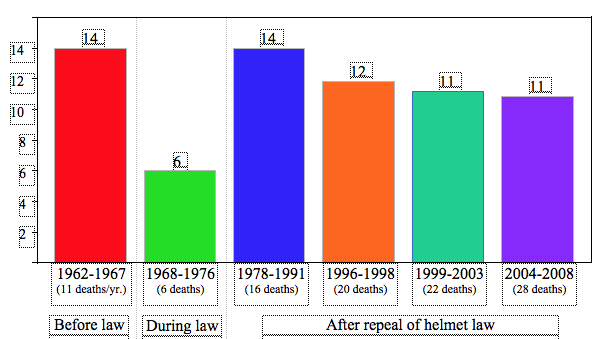
Hawaii’s fatality rates before, during, and after the repeal of mandatory helmet use
Motorcyclist fatality rates (per 10,000 registered motorcycles) in Hawaii, by aggregated time periods, 1962-2008 FARS/DOT.
Helmets: Properly worn helmets prevent deaths and brain injuries. In the event of a crash, helmets reduce the risk of death by 42% and the risk of head injury by 69% (Liu, et al. 2008). States that have enacted universal helmet laws have seen significant reductions in fatality rates, head injuries and overall medical expenses related to motorcycle injuries (NHTSA)
Hawaii Moped and Motorcycle Safety Strategies
Hawaii Injury Prevention Plan: According to the newest Hawaii Injury Prevention Plan, more than one-third (35%) of motorcycle/moped riders were not wearing a helmet. A core strategy of this updated 2018-2023 plan is to promote policies that encourage use of protective devices (helmets and seat belts).
 Hawaii Strategic Highway Safety Plan 2019-2024: The Hawaii Strategic Highway Safety Plan has 8 Emphasis Areas aimed at reducing traffic related fatalities and injuries. Motorcycle and Moped Safety is one of the 8 emphasis areas listing over 12 strategies addressing the issues around improving motorcycle and moped safety in Hawaii.
Hawaii Strategic Highway Safety Plan 2019-2024: The Hawaii Strategic Highway Safety Plan has 8 Emphasis Areas aimed at reducing traffic related fatalities and injuries. Motorcycle and Moped Safety is one of the 8 emphasis areas listing over 12 strategies addressing the issues around improving motorcycle and moped safety in Hawaii.
Injury Prevention Program works with Department of Transportation and other Traffic Safety Partners to develop strategies for the Hawaii Strategic Highway Safety Plan.
Community Collaboration
- Hawaii Department of Transportation Strategic Highway Safety Plan
- Hawaii State Highway Safety Council
- Hawaii Department of Transportation
Resources and Links
- 2007-2011 Oahu EMS Responses to Motor Vehicle Crashes
- Hawaii SHSP (Strategic Highway Safety Plan) Website
- Motorcycle Safety Courses UH
- National Highway Traffic Safety Administration (NHTSA)

